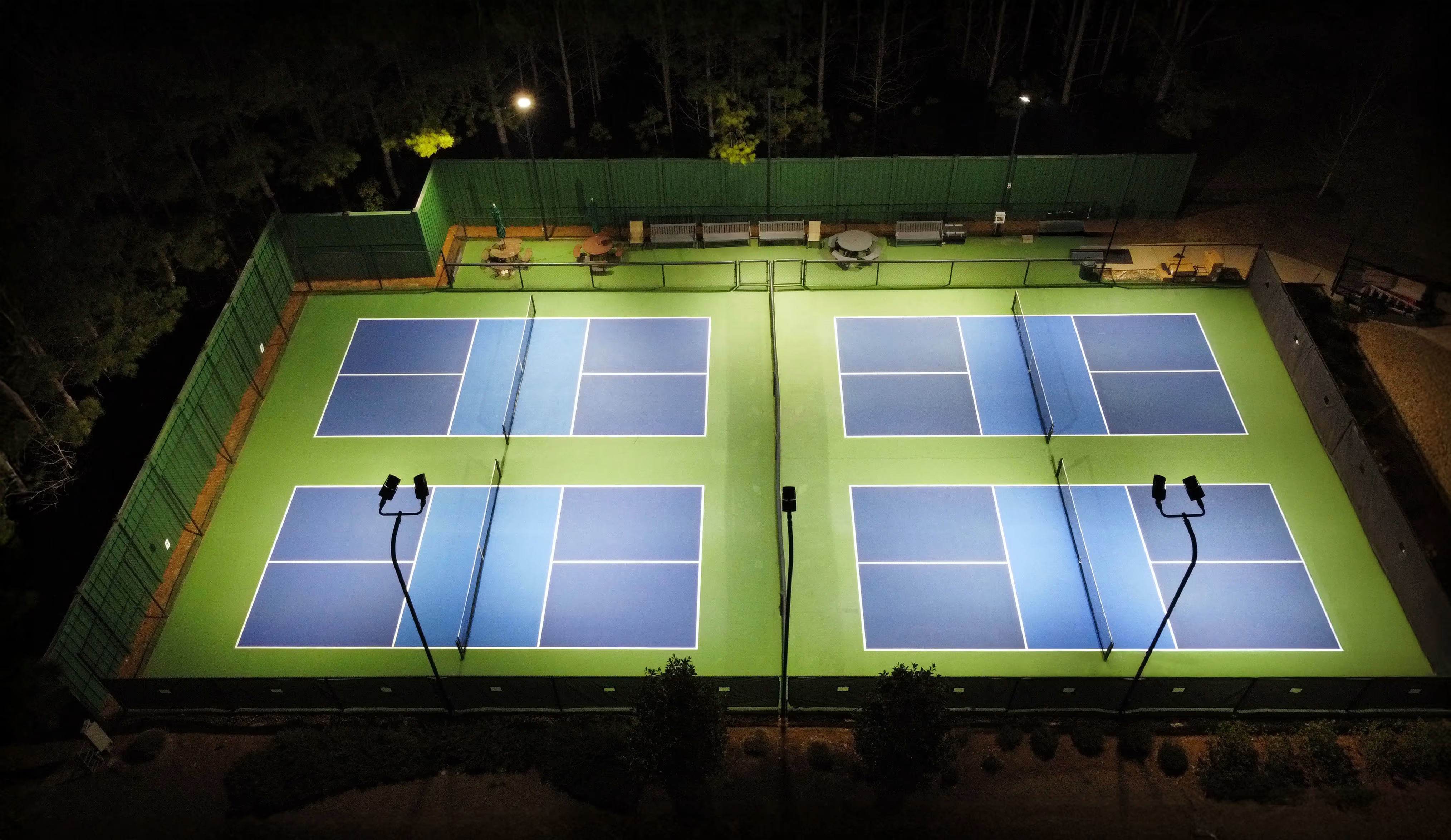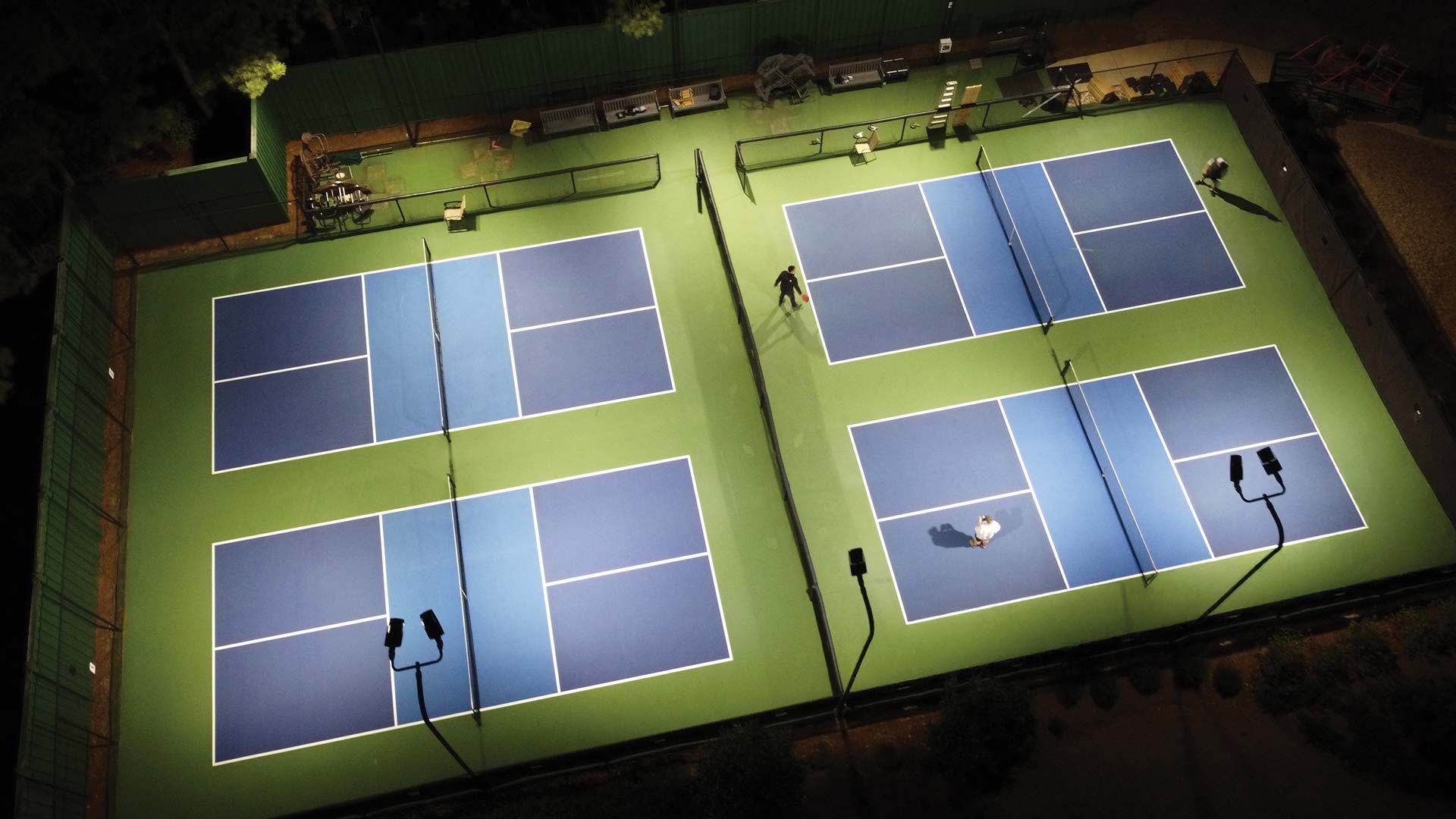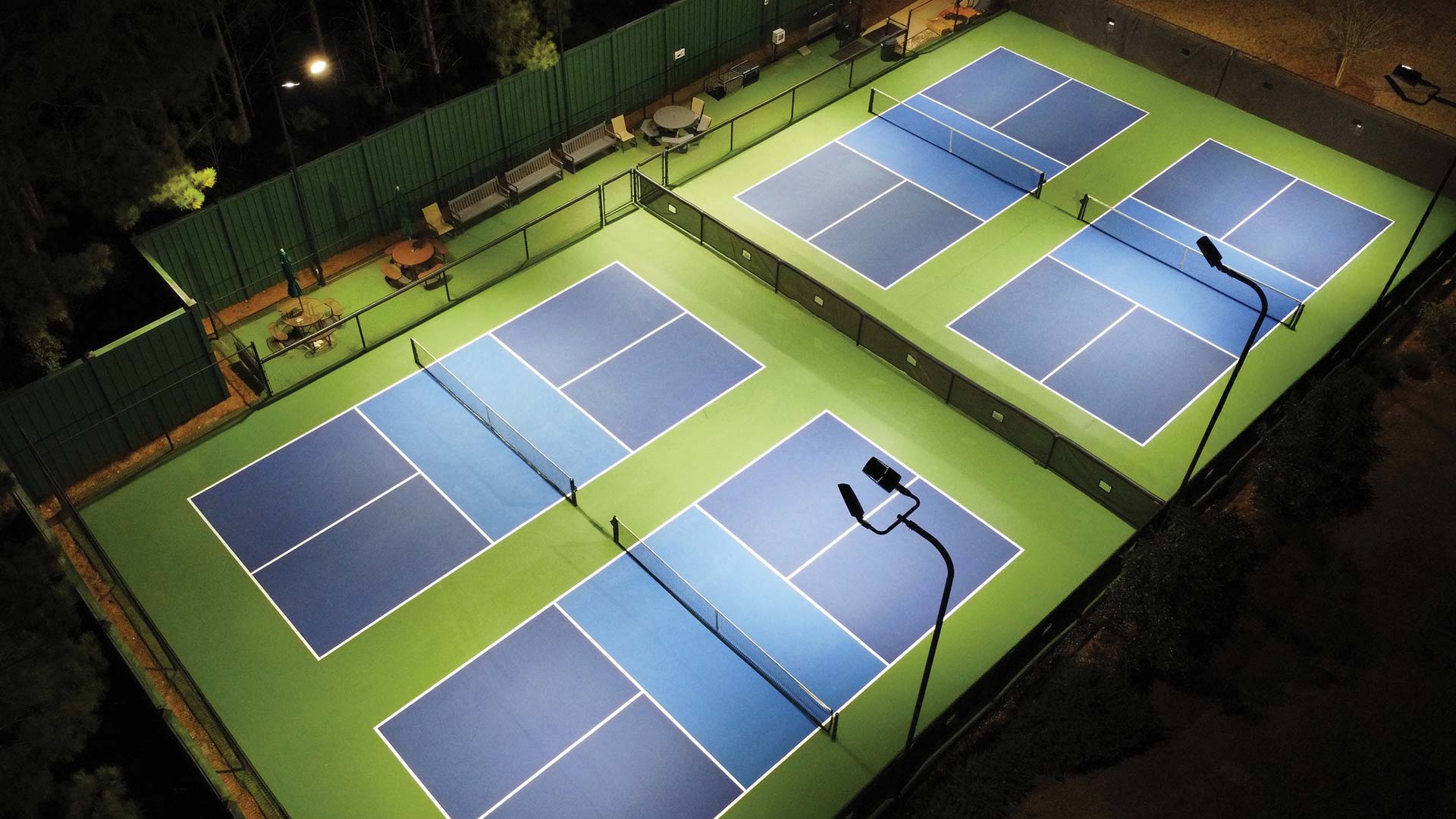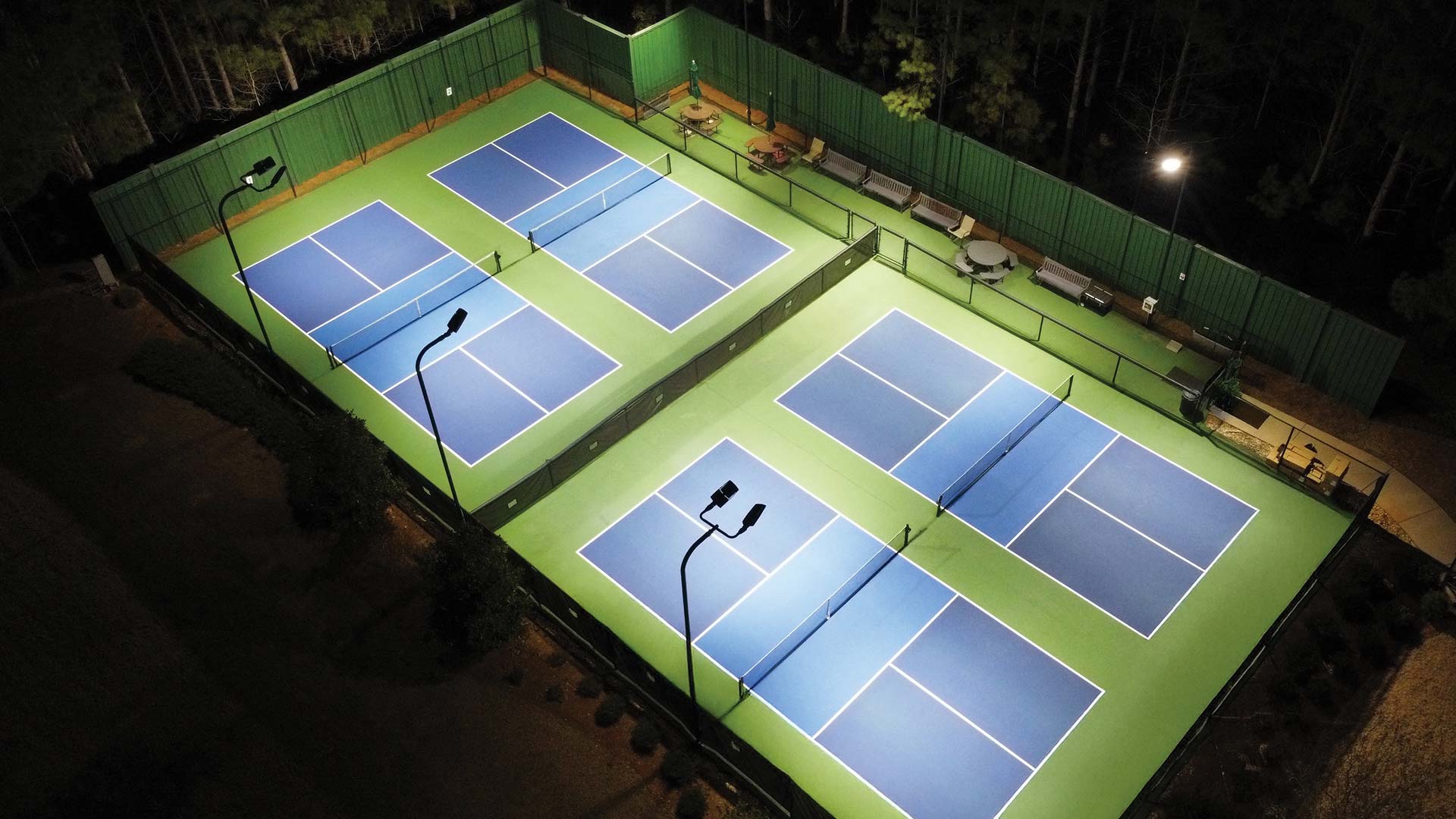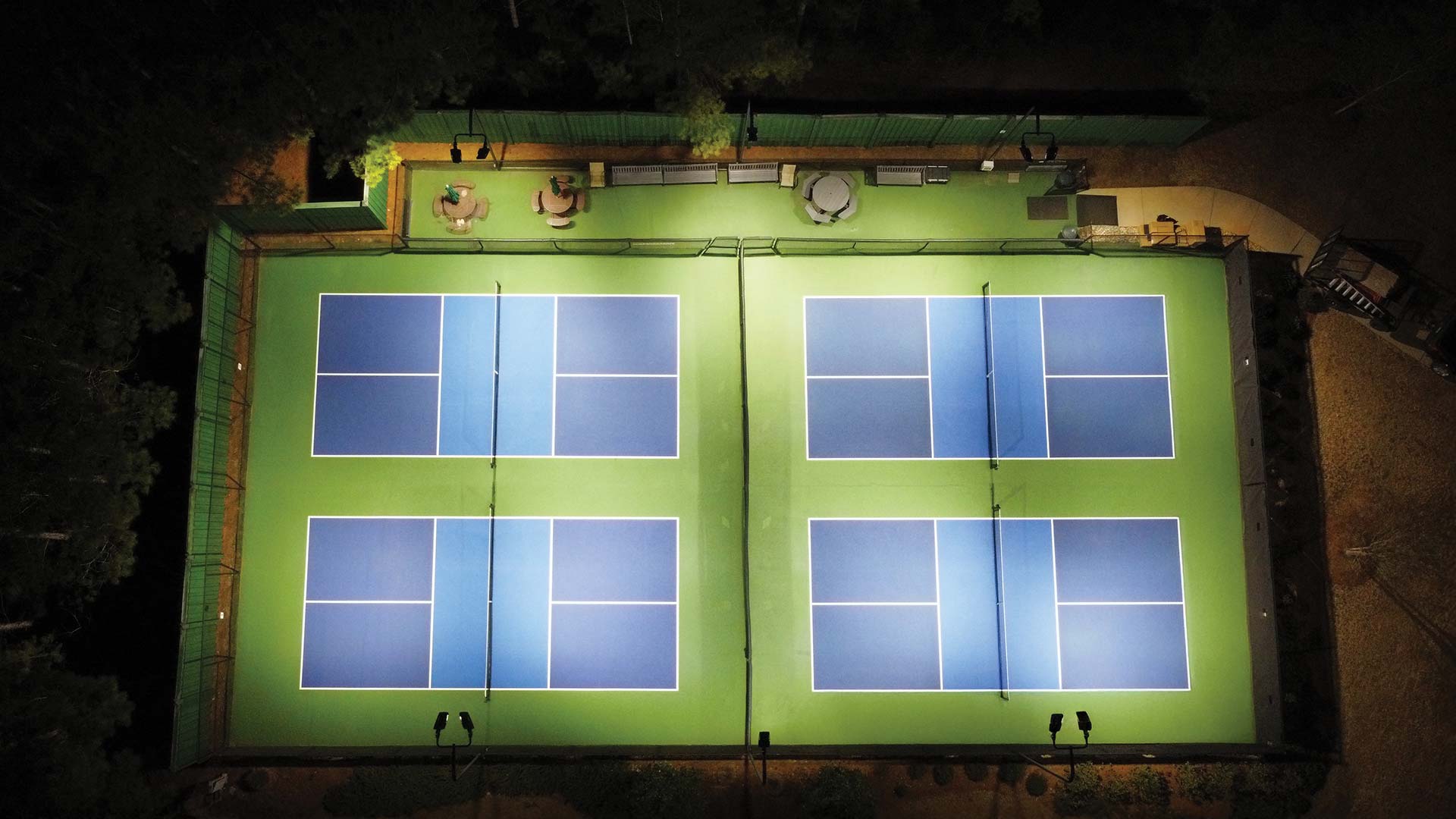PROJECT DETAILS
Lighting Up the Game: How New Court Lighting Revitalized Pickleball at Del Webb
At Del Webb at Lake Oconee, a 55+ active adult community in Greensboro, Georgia, pickleball is more than a casual pastime – it’s a social institution. As the sport surged in popularity among residents and surrounding communities, the courts became a hub for recreation and competition. However, more people using the courts meant that evening play became more common, and the community’s outdated court lighting became an unwelcome barrier.
Inconsistent illumination, harsh glare, and deep shadows made it difficult for players, especially those with age-related vision sensitivities, to see the ball clearly, particularly after sundown. Participation began to decline as limited evening visibility made it difficult for residents to fit this popular activity into their schedules.
Lithonia Lighting’s involvement began when Tony Gineris, VP & GM Industrial and Outdoor, Acuity Brands Lighting (ABL), who plays regularly on the Del Webb courts, experienced the lighting challenges firsthand. Alongside Eric Gibson, Director, Product Market Commercial Outdoor, ABL, the team from Lithonia Lighting took light level readings and immediately identified considerable gaps – the courts were underlit and unevenly illuminated.
“When it comes to sports and activities at night, it’s not just about having enough light – it’s about achieving even illumination,” said Gineris. “For court sports especially, it’s imperative to eliminate dark spots and hot spots to ensure both performance and safety. We knew Acuity could provide the products and solution to meet these critical needs for our customer.”
Understanding the Community’s Needs
The first step was clear: understand the players. Gibson explained that by engaging directly with the community, the team quickly realized that enhanced lighting wasn’t just a preference, it was essential.
“In speaking with the residents who play on these courts, we identified immediately that additional illumination levels were required – not only to accommodate the evolving level of play, which now includes frequent nighttime regional tournaments, but also to better support the visual comfort of the players in this active-living community,” said Gibson. “Without understanding the customer’s needs, it would not have been possible to provide such an effective solution.”
A Seamless, Scalable Installation
The project team collaborated with John Matheson, president of the Del Webb Pickleball Club, and Ray Alberti, another highly engaged community member, to implement a lighting solution from Lithonia Lighting that would meet both performance standards and community needs.
Thanks to the smart design, no structural changes were needed. The team selected Lithonia RSXF2 LED Floodlights, which offer five unique mounting options and are specifically designed to provide one-for-one replacements for existing metal halide or high-pressure sodium lighting, making them an ideal fit for retrofit applications like this. Known for their wide range of flood photometric distributions, the RSXF floodlights deliver superior illumination.
These fixtures were mounted directly onto the existing poles, and the new layout dramatically improved both brightness and uniformity, raising minimum light levels to approximately 20-foot candles and peak levels to 45. The result: a four times increase in light levels and significantly enhanced visibility and consistency across the court surface.
A local contractor handled the physical installation, while the Lithonia team remained actively involved throughout, staying through the evening to perform precise aiming and fine-tuning to ensure optimal light coverage without glare. Drone photography captured compelling before-and-after visuals, clearly illustrating the dramatic transformation.
For the Del Webb Pickleball Club and their HOA, documentation and communication were key. The Lithonia team provided comprehensive photometric plans and clear visuals, making it easy for stakeholders to understand what to expect and why it mattered. The cost of switching to the RSXF luminaires was an important factor in the decision-making process. With the energy savings and improved efficiency, the cost to operate the court lighting is now less than $100 per year.
“They explained everything in terms I could take back to the HOA,” said Matheson. “That made it easy to get buy-in. They even gave us side-by-side visuals that showed exactly how much better the lighting would be.”
And when the lights came on, the results spoke for themselves.
Bright Results, Lasting Impact
Since the new lighting system was installed, the transformation is significant. The courts are now evenly illuminated, with no distracting shadows or blinding glare. Players have noticed an immediate improvement in visibility, and evening participation has surged.
“Before the change, the lighting actually kept people from playing,” said Alberti. “Now, it’s the opposite, we have more people showing up in the evenings. And what’s really impressive is that the lights don’t blind you, even on high balls. They did a great job angling everything just right.”
The upgrade also enables Del Webb to host regional tournaments, something that would have been unlikely under the old lighting conditions.
A Model for Recreational Spaces
The ripple effect is already being felt beyond the community. Visitors from surrounding neighborhoods have taken note of the high-quality lighting, and some are beginning to explore similar upgrades. In fact, Del Webb is now working with Lithonia to hopefully extend the same lighting solution to its remaining two pickleball courts and tennis courts.
For Del Webb, lighting performance isn’t just about fixtures – it’s about giving the community more time to play and connect. By focusing on quality of light and putting people at the center of the design, Lithonia Lighting helped turn a lighting challenge into a community win.
Project: Del Webb Pickleball Courts
Electrical Contractor: Power Pro Electric
Lighting & Controls Manufacturer: Lithonia Lighting®
Products: RSXF2 LED Floodlights
Photographer: Tremayne Williams
At Del Webb at Lake Oconee, a 55+ active adult community in Greensboro, Georgia, pickleball is more than a casual pastime – it’s a social institution. As the sport surged in popularity among residents and surrounding communities, the courts became a hub for recreation and competition. However, more people using the courts meant that evening play became more common, and the community’s outdated court lighting became an unwelcome barrier.
Inconsistent illumination, harsh glare, and deep shadows made it difficult for players, especially those with age-related vision sensitivities, to see the ball clearly, particularly after sundown. Participation began to decline as limited evening visibility made it difficult for residents to fit this popular activity into their schedules.
Lithonia Lighting’s involvement began when Tony Gineris, VP & GM Industrial and Outdoor, Acuity Brands Lighting (ABL), who plays regularly on the Del Webb courts, experienced the lighting challenges firsthand. Alongside Eric Gibson, Director, Product Market Commercial Outdoor, ABL, the team from Lithonia Lighting took light level readings and immediately identified considerable gaps – the courts were underlit and unevenly illuminated.
“When it comes to sports and activities at night, it’s not just about having enough light – it’s about achieving even illumination,” said Gineris. “For court sports especially, it’s imperative to eliminate dark spots and hot spots to ensure both performance and safety. We knew Acuity could provide the products and solution to meet these critical needs for our customer.”
Understanding the Community’s Needs
The first step was clear: understand the players. Gibson explained that by engaging directly with the community, the team quickly realized that enhanced lighting wasn’t just a preference, it was essential.
“In speaking with the residents who play on these courts, we identified immediately that additional illumination levels were required – not only to accommodate the evolving level of play, which now includes frequent nighttime regional tournaments, but also to better support the visual comfort of the players in this active-living community,” said Gibson. “Without understanding the customer’s needs, it would not have been possible to provide such an effective solution.”
A Seamless, Scalable Installation
The project team collaborated with John Matheson, president of the Del Webb Pickleball Club, and Ray Alberti, another highly engaged community member, to implement a lighting solution from Lithonia Lighting that would meet both performance standards and community needs.
Thanks to the smart design, no structural changes were needed. The team selected Lithonia RSXF2 LED Floodlights, which offer five unique mounting options and are specifically designed to provide one-for-one replacements for existing metal halide or high-pressure sodium lighting, making them an ideal fit for retrofit applications like this. Known for their wide range of flood photometric distributions, the RSXF floodlights deliver superior illumination.
These fixtures were mounted directly onto the existing poles, and the new layout dramatically improved both brightness and uniformity, raising minimum light levels to approximately 20-foot candles and peak levels to 45. The result: a four times increase in light levels and significantly enhanced visibility and consistency across the court surface.
A local contractor handled the physical installation, while the Lithonia team remained actively involved throughout, staying through the evening to perform precise aiming and fine-tuning to ensure optimal light coverage without glare. Drone photography captured compelling before-and-after visuals, clearly illustrating the dramatic transformation.
For the Del Webb Pickleball Club and their HOA, documentation and communication were key. The Lithonia team provided comprehensive photometric plans and clear visuals, making it easy for stakeholders to understand what to expect and why it mattered. The cost of switching to the RSXF luminaires was an important factor in the decision-making process. With the energy savings and improved efficiency, the cost to operate the court lighting is now less than $100 per year.
“They explained everything in terms I could take back to the HOA,” said Matheson. “That made it easy to get buy-in. They even gave us side-by-side visuals that showed exactly how much better the lighting would be.”
And when the lights came on, the results spoke for themselves.
Bright Results, Lasting Impact
Since the new lighting system was installed, the transformation is significant. The courts are now evenly illuminated, with no distracting shadows or blinding glare. Players have noticed an immediate improvement in visibility, and evening participation has surged.
“Before the change, the lighting actually kept people from playing,” said Alberti. “Now, it’s the opposite, we have more people showing up in the evenings. And what’s really impressive is that the lights don’t blind you, even on high balls. They did a great job angling everything just right.”
The upgrade also enables Del Webb to host regional tournaments, something that would have been unlikely under the old lighting conditions.
A Model for Recreational Spaces
The ripple effect is already being felt beyond the community. Visitors from surrounding neighborhoods have taken note of the high-quality lighting, and some are beginning to explore similar upgrades. In fact, Del Webb is now working with Lithonia to hopefully extend the same lighting solution to its remaining two pickleball courts and tennis courts.
For Del Webb, lighting performance isn’t just about fixtures – it’s about giving the community more time to play and connect. By focusing on quality of light and putting people at the center of the design, Lithonia Lighting helped turn a lighting challenge into a community win.
Project: Del Webb Pickleball Courts
Electrical Contractor: Power Pro Electric
Lighting & Controls Manufacturer: Lithonia Lighting®
Products: RSXF2 LED Floodlights
Photographer: Tremayne Williams
SHARE
VISIT PROJECT
